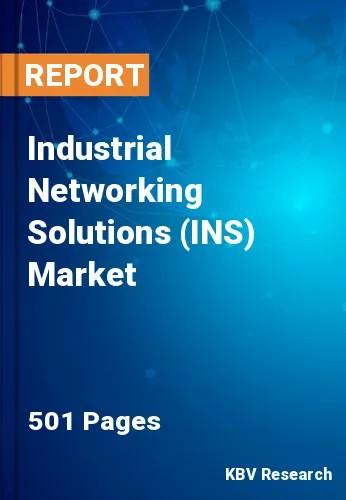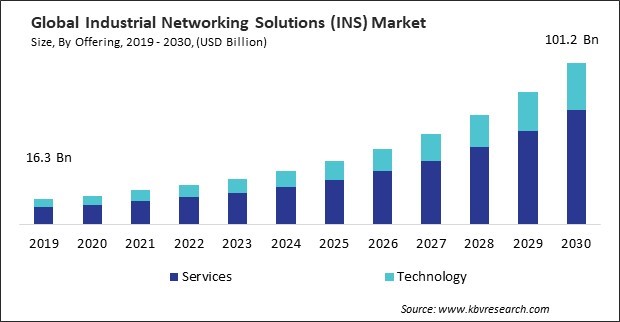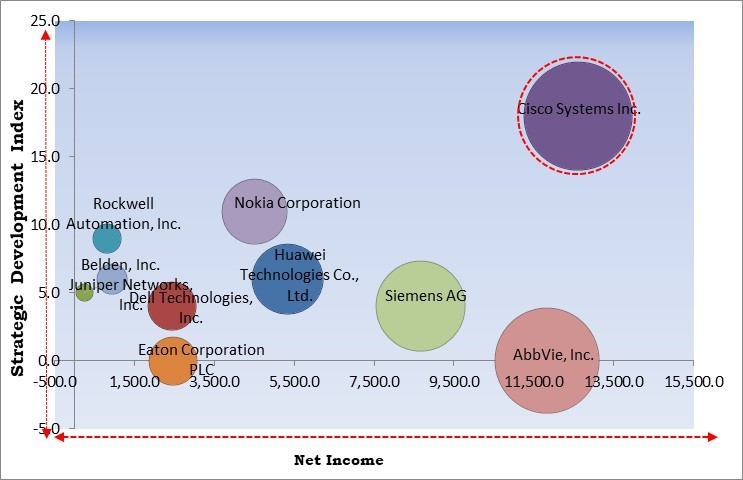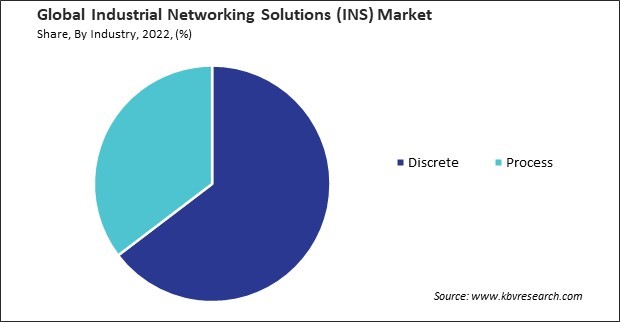
“Global Industrial Networking Solutions (INS) Market to reach a market value of USD 101.2 Billion by 2030 growing at a CAGR of 19.7%”
The Global Industrial Networking Solutions (INS) Market size is expected to reach $101.2 billion by 2030, rising at a market growth of 19.7% CAGR during the forecast period.
Real-time video streaming is employed for quality control and inspection processes. Cameras and sensors capture visual data, allowing operators to inspect products and identify defects as they occur in real-time. Therefore, the Real-time video streaming segment captured $1,882.1million revenue in the market in 2022. Real-time video streaming enhances emergency response and crisis management. During incidents, security personnel and emergency responders can access live video feeds to assess the situation, coordinate responses, and make informed decisions.

The major strategies followed by the market participants is Partnership as the key developmental strategy to keep pace with the changing demands of end users. For instance, In May 2022, Cisco Systems Inc. came into partnership with VNPT Group, a telecommunications company in Vietnam. Through this partnership, Cisco Systems Inc. would provide advanced connectivity solutions for enterprises in Vietnam. Additionally, In September 2023, Huawei Technologies Co., Ltd. Introduced "High-Quality Smart Wards, High-Quality SME Office and High-Quality Simplified Data Centers". These product portfolios would assist partners in acquiring additional customers and attaining greater success in the commercial market.
Based on the Analysis presented in the KBV Cardinal matrix, Cisco Systems Inc. is the forerunner in the Market. In September, 2023 Juniper Networks, Inc. came into partnership with Granite Telecommunications LLC, a telecommunications company. Through this partnership, Juniper Networks, Inc. would offer its customers full campus and branch networking solutions. Companies such as AbbVie, Inc., Siemens AG and Huawei Technologies Co., Ltd. Are some of the key innovators in Market.

IIoT relies on extensive connectivity between various industrial devices, sensors, and systems. As connected devices grow, the demand for robust solutions supporting increased connectivity requirements rises. IIoT generates vast amounts of data from sensors and devices across industrial environments. Industrial networking solutions facilitate the seamless transmission of this data, allowing organizations to make data-driven decisions for optimizing processes, predicting maintenance needs, and improving overall efficiency. Additionally, Advancements in wireless communication technologies, such as 5G, provide high-speed connectivity for industrial applications. This enables the rapid and efficient transfer of large volumes of data, supporting real-time monitoring, control, and data analytics in industrial settings. Technologies like 5G and Wi-Fi 6 offer low-latency communication, making them suitable for real-time applications in industrial environments. This is crucial for machine control, robotics, and augmented reality (AR) applications, where low latency is essential for seamless operation. Advancements in wireless communication ensure increased reliability and robustness, even in challenging industrial environments. Improved signal strength, interference mitigation, and reliability enhancements contribute to deploying more dependable wireless solutions.
The initial capital expenditure required for purchasing networking hardware, software, and associated infrastructure can be a barrier for organizations, particularly smaller ones. High upfront costs deter potential adopters from investing in this. Integrating it with existing systems, including legacy equipment, may require additional investments. The complexity of integration can lead to higher costs, and organizations might be hesitant to incur such expenses. Organizations relying on legacy systems may need to upgrade their infrastructure to align with modern solutions. Upgrading or replacing outdated equipment can be a substantial investment, particularly for long-established industrial facilities. Due to the above factors, market growth will be hampered in the coming years.
On the basis of offering, the market is segmented into technology and services. In 2022, the services segment dominated the market with the maximum revenue share. Integration services focus on connecting diverse industrial devices, sensors, and systems into a cohesive and interoperable network. This involves integrating different communication protocols, ensuring legacy and modern equipment compatibility, and facilitating seamless data exchange across the industrial ecosystem. Consulting services involve in-depth assessments of industrial infrastructures to identify networking needs, challenges, and opportunities. This includes evaluating existing networking capabilities, understanding specific industry requirements, and providing recommendations for optimizing or upgrading network infrastructure.
By services, the industrial networking solutions (INS) market is categorised into network planning & optimization, network integration, network orchestration, training & education, network consulting, network security, network adulting & testing, support & maintenance, and others. In 2022, the network planning & optimization segment registered the highest revenue share in the industrial networking solutions (INS) market. Network planning & optimization identifies the specific requirements of the industrial processes, considering factors such as real-time communication needs, data volume, latency constraints, and the diversity of connected devices. This prevents congestion on specific network links and ensures efficient utilization of available resources. Industrial processes often require deterministic communication, where the timing and reliability of data transmission are critical. Network planning involves selecting technologies and protocols that support deterministic communication, such as time-sensitive networking (TSN).
Based on technology, the industrial networking solutions (INS) market is fragmented into SD-WAN, WLAN, and IIoT. The WLAN segment held the highest revenue share in the industrial networking solutions (INS) market in 2022. Wireless clients are the devices, such as laptops, smartphones, and tablets, that connect to the WLAN. These devices use Wi-Fi adapters to establish wireless connections to access points and communicate with other devices on the network. WLANs operate based on IEEE 802.11 standards, commonly known as Wi-Fi standards. These standards define the protocols and specifications for wireless communication, including data rates, frequency bands, and security features. Common Wi-Fi standards include 802.11a, 802.11b, 802.11g, 802.11n, 802.11ac, and 802.11ax (Wi-Fi 6).
By industry, the market is bifurcated into discrete and process. The process segment garnered a remarkable growth rate in the market in 2022. The process industry is subject to strict safety and regulatory compliance requirements. Industrial networking solutions help ensure compliance by providing real-time monitoring of critical parameters and enabling quick response to potential issues. The process industry often involves large and expensive assets, such as machinery and equipment. Industrial networking solutions support asset management by providing real-time data on asset performance, enabling predictive maintenance and extending asset lifecycles.

Based on discrete type, the industrial networking solutions (INS) market is divided into machine manufacturing, automotive, semiconductor & electronics, medical devices, and others. The machine manufacturing segment dominated the industrial networking solutions (INS) market in 2022. Machine manufacturing involves the use of automation and robotics to improve efficiency and productivity. Industrial networking solutions enable the integration of these technologies, allowing for seamless communication between machines and systems. The use of industrial networking solutions in machine manufacturing is driven by the need for improved efficiency, productivity, and reliability. As technology continues to advance, these solutions are expected to play an increasingly important role in optimizing machine performance and driving innovation in the industry.
On the basis of process type, the industrial networking solutions (INS) market is segmented into energy & utilities, chemicals & materials, food & beverage, waste & water management, and others. The energy & utilities segment covered the highest revenue share in the industrial networking solutions (INS) market in 2022. The adoption of smart grid technologies, which enable two-way communication between utilities and consumers, is driving the need for industrial networking solutions. These solutions allow for real-time monitoring and control of energy distribution, improving efficiency and reliability. Industrial networking solutions enable utilities to collect and analyze data from various sources, such as smart meters and sensors, to optimize energy production, distribution, and consumption. This data-driven approach helps utilities improve efficiency and reduce costs.
Based on application, the market is divided into remote monitoring, asset tracking & management, supply chain management, real-time streaming & video, emergency & incident management, and predictive maintenance. The asset tracking & management segment garnered a significant revenue share in the market in 2022. Industrial networking solutions enable real-time tracking of assets within a facility or across multiple locations. Using technologies such as RFID (Radio-Frequency Identification), GPS (Global Positioning System), and sensors, enterprises can precisely monitor the location and movement of assets. Asset tracking solutions integrated with industrial networks assist inventory control by providing real-time visibility into stock levels, usage patterns, and replenishment needs. This enhances inventory management processes, reduces stockouts, and minimizes excess inventory.
Free Valuable Insights: Global Industrial Networking Solutions (INS) Market size to reach USD 101.2 Billion by 2030
Region-wise, the market is analysed across North America, Europe, Asia Pacific, and LAMEA. The Asia Pacific region covered a considerable revenue share in the market in 2022. Automation, government support, and a prospering manufacturing sector are a few of the key factors that dynamically impact the market in the Asia-Pacific region. Technological advancements have played a pivotal role in enhancing connectivity and real-time monitoring in industrial settings. The growth of the market has been aided by the regional acceleration of smart manufacturing, digital transformation, and infrastructural development brought about by government initiatives. Global and regional players offer diverse products and services, addressing the unique needs of various industry verticals such as manufacturing, energy, transportation, and healthcare.
| Report Attribute | Details |
|---|---|
| Market size value in 2022 | USD 24.7 Billion |
| Market size forecast in 2030 | USD 101.2 Billion |
| Base Year | 2022 |
| Historical Period | 2019 to 2021 |
| Forecast Period | 2023 to 2030 |
| Revenue Growth Rate | CAGR of 19.7% from 2023 to 2030 |
| Number of Pages | 501 |
| Number of Tables | 813 |
| Report coverage | Market Trends, Revenue Estimation and Forecast, Segmentation Analysis, Regional and Country Breakdown, Competitive Landscape, Porter’s 5 Forces Analysis, Company Profiling, Companies Strategic Developments, SWOT Analysis, Winning Imperatives |
| Segments covered | Offering, Application, Industry, Region |
| Country scope |
|
| Companies Included | Cisco Systems Inc., Juniper Networks, Inc., Huawei Technologies Co., Ltd. (Huawei Investment & Holding Co., Ltd.), Dell Technologies, Inc., Rockwell Automation, Inc., Eaton Corporation PLC, Nokia Corporation, AbbVie, Inc., Belden, Inc., Siemens AG |
By Offering
By Industry
By Application
By Geography
This Market size is expected to reach $101.2 billion by 2030.
Rising demand in industrial IoT (IIoT) are driving the Market in coming years, however, High cost of implementation restraints the growth of the Market.
Cisco Systems Inc., Juniper Networks, Inc., Huawei Technologies Co., Ltd. (Huawei Investment & Holding Co., Ltd.), Dell Technologies, Inc., Rockwell Automation, Inc., Eaton Corporation PLC, Nokia Corporation, AbbVie, Inc., Belden, Inc., Siemens AG
The expected CAGR of this Market is 19.7% from 2023 to 2030.
The Discrete segment is leading the Market by Industry in 2022; there by, achieving a market value of $63.5 billion by 2030.
The North America region dominated the Market by Region in 2022, and would continue to be a dominant market till 2030; there by, achieving a market value of $34.08 billion by 2030.
Our team of dedicated experts can provide you with attractive expansion opportunities for your business.
 Drivers
Drivers
 Restraints
Restraints
 Opportunities
Opportunities
 Challenges
Challenges
